BMW X5 XDRIVE35D 2012 Owners Manual
Manufacturer: BMW, Model Year: 2012, Model line: X5 XDRIVE35D, Model: BMW X5 XDRIVE35D 2012Pages: 317, PDF Size: 8.83 MB
Page 251 of 317
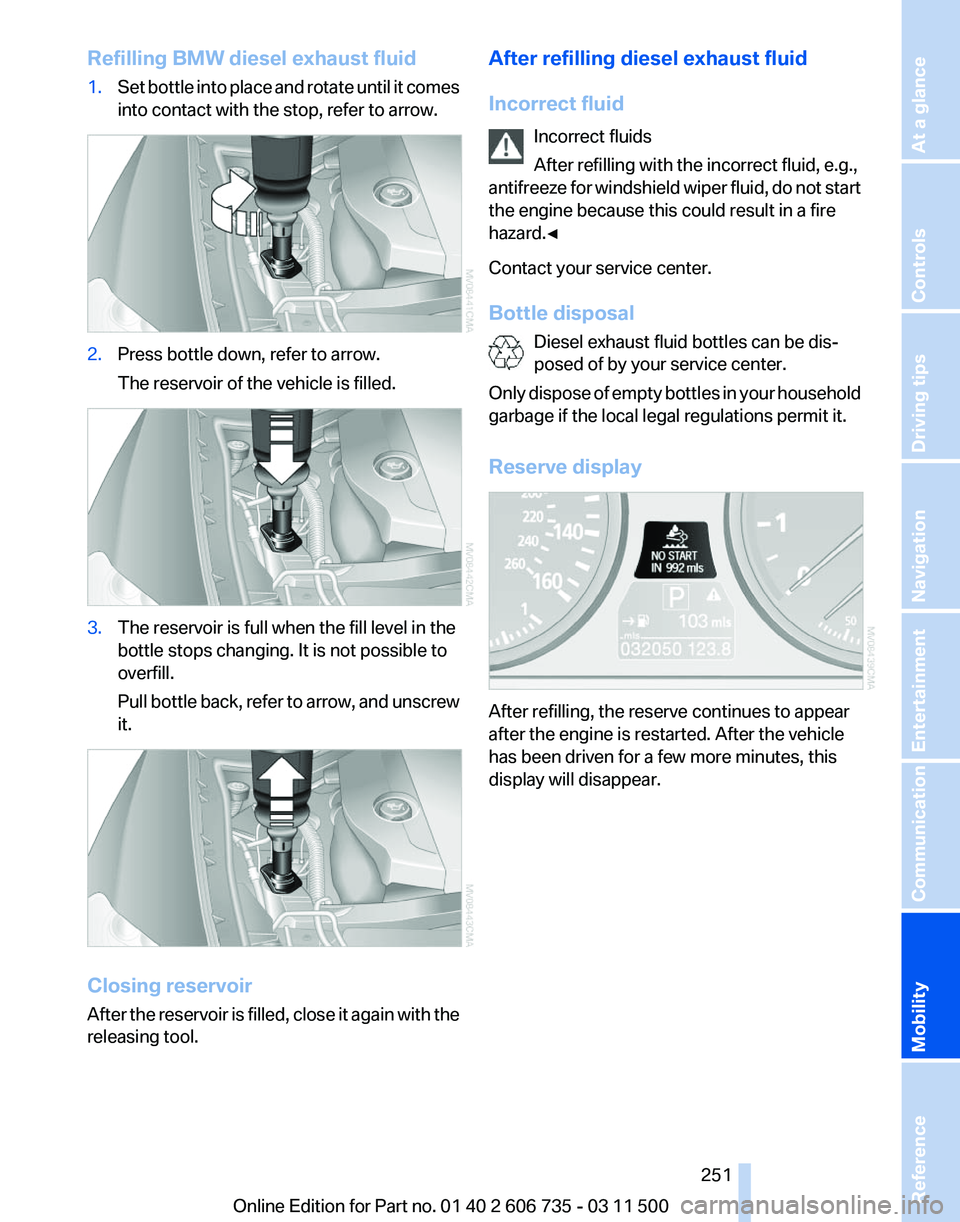
Refilling BMW diesel exhaust fluid
1.
Set bottle into place and rotate until it comes
into contact with the stop, refer to arrow. 2.
Press bottle down, refer to arrow.
The reservoir of the vehicle is filled. 3.
The reservoir is full when the fill level in the
bottle stops changing. It is not possible to
overfill.
Pull
bottle back, refer to arrow, and unscrew
it. Closing reservoir
After
the reservoir is filled, close it again with the
releasing tool. After refilling diesel exhaust fluid
Incorrect fluid
Incorrect fluids
After refilling with the incorrect fluid, e.g.,
antifreeze
for windshield wiper fluid, do not start
the engine because this could result in a fire
hazard.◀
Contact your service center.
Bottle disposal
Diesel exhaust fluid bottles can be dis‐
posed of by your service center.
Only dispose of empty bottles in your household
garbage if the local legal regulations permit it.
Reserve display After refilling, the reserve continues to appear
after the engine is restarted. After the vehicle
has been driven for a few more minutes, this
display will disappear. Seite 251
251Online Edition for Part no. 01 40 2 606 735 - 03 11 500
Reference
Mobility Communication Entertainment Navigation Driving tips Controls At a glance
Page 252 of 317
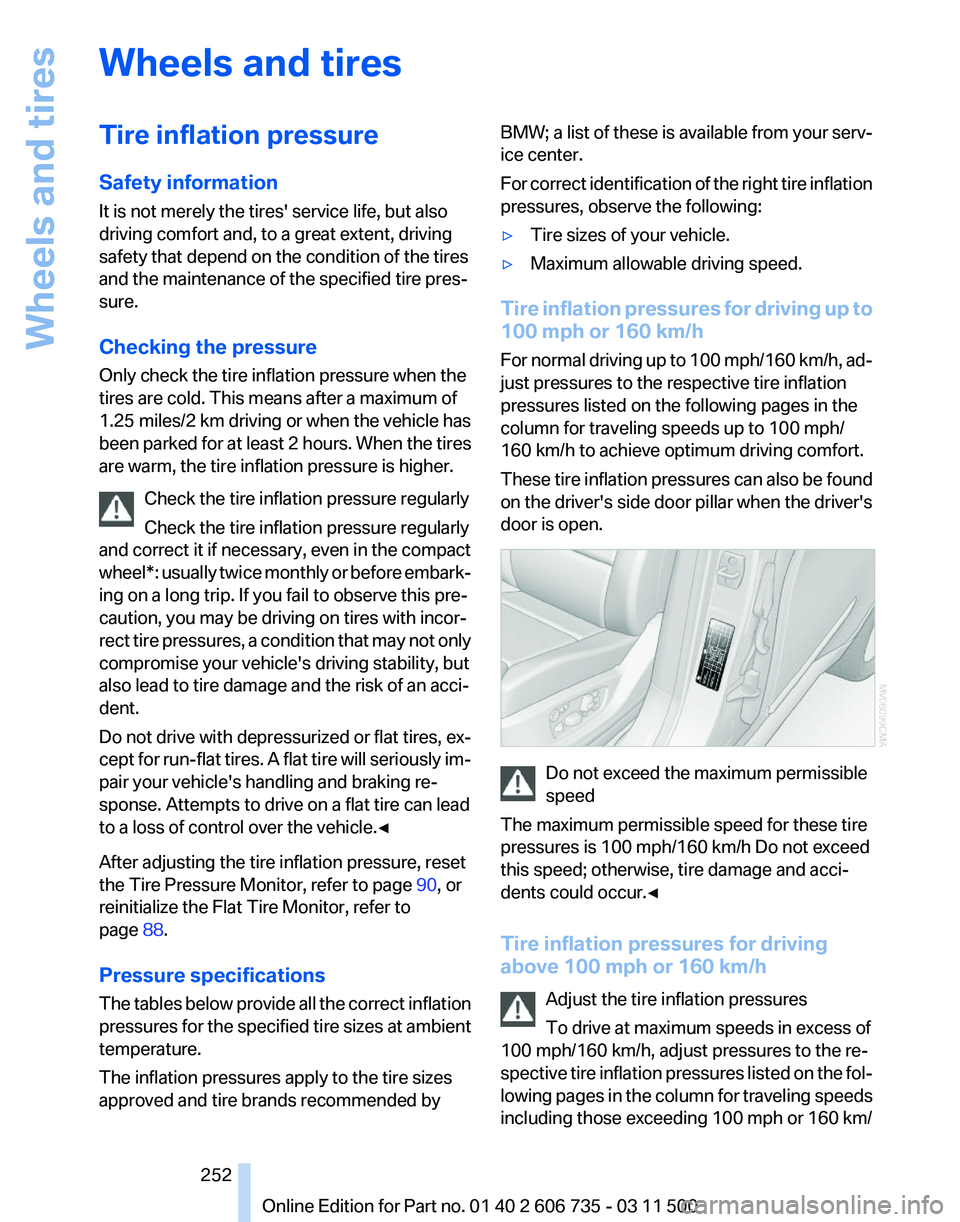
Wheels and tires
Tire inflation pressure
Safety information
It is not merely the tires' service life, but also
driving comfort and, to a great extent, driving
safety that depend on the condition of the tires
and the maintenance of the specified tire pres‐
sure.
Checking the pressure
Only check the tire inflation pressure when the
tires are cold. This means after a maximum of
1.25
miles/2 km driving or when the vehicle has
been parked for at least 2 hours. When the tires
are warm, the tire inflation pressure is higher.
Check the tire inflation pressure regularly
Check the tire inflation pressure regularly
and correct it if necessary, even in the compact
wheel*: usually twice monthly or before embark‐
ing on a long trip. If you fail to observe this pre‐
caution, you may be driving on tires with incor‐
rect tire pressures, a condition that may not only
compromise your vehicle's driving stability, but
also lead to tire damage and the risk of an acci‐
dent.
Do not drive with depressurized or flat tires, ex‐
cept for run-flat tires. A flat tire will seriously im‐
pair your vehicle's handling and braking re‐
sponse. Attempts to drive on a flat tire can lead
to a loss of control over the vehicle.◀
After adjusting the tire inflation pressure, reset
the Tire Pressure Monitor, refer to page 90, or
reinitialize the Flat Tire Monitor, refer to
page 88.
Pressure specifications
The tables below provide all the correct inflation
pressures for the specified tire sizes at ambient
temperature.
The inflation pressures apply to the tire sizes
approved and tire brands recommended by BMW; a list of these is available from your serv‐
ice center.
For
correct identification of the right tire inflation
pressures, observe the following:
▷ Tire sizes of your vehicle.
▷ Maximum allowable driving speed.
Tire inflation pressures for driving up to
100 mph or 160 km/h
For
normal driving up to 100 mph/160 km/h, ad‐
just pressures to the respective tire inflation
pressures listed on the following pages in the
column for traveling speeds up to 100 mph/
160 km/h to achieve optimum driving comfort.
These tire inflation pressures can also be found
on the driver's side door pillar when the driver's
door is open. Do not exceed the maximum permissible
speed
The maximum permissible speed for these tire
pressures is 100 mph/160 km/h Do not exceed
this speed; otherwise, tire damage and acci‐
dents could occur.◀
Tire inflation pressures for driving
above 100 mph or 160 km/h
Adjust the tire inflation pressures
To drive at maximum speeds in excess of
100 mph/160 km/h, adjust pressures to the re‐
spective
tire inflation pressures listed on the fol‐
lowing pages in the column for traveling speeds
including those exceeding 100 mph or 160 km/ Seite 252
252 Online Edition for Part no. 01 40 2 606 735 - 03 11 500
Wheels and tires
Page 253 of 317
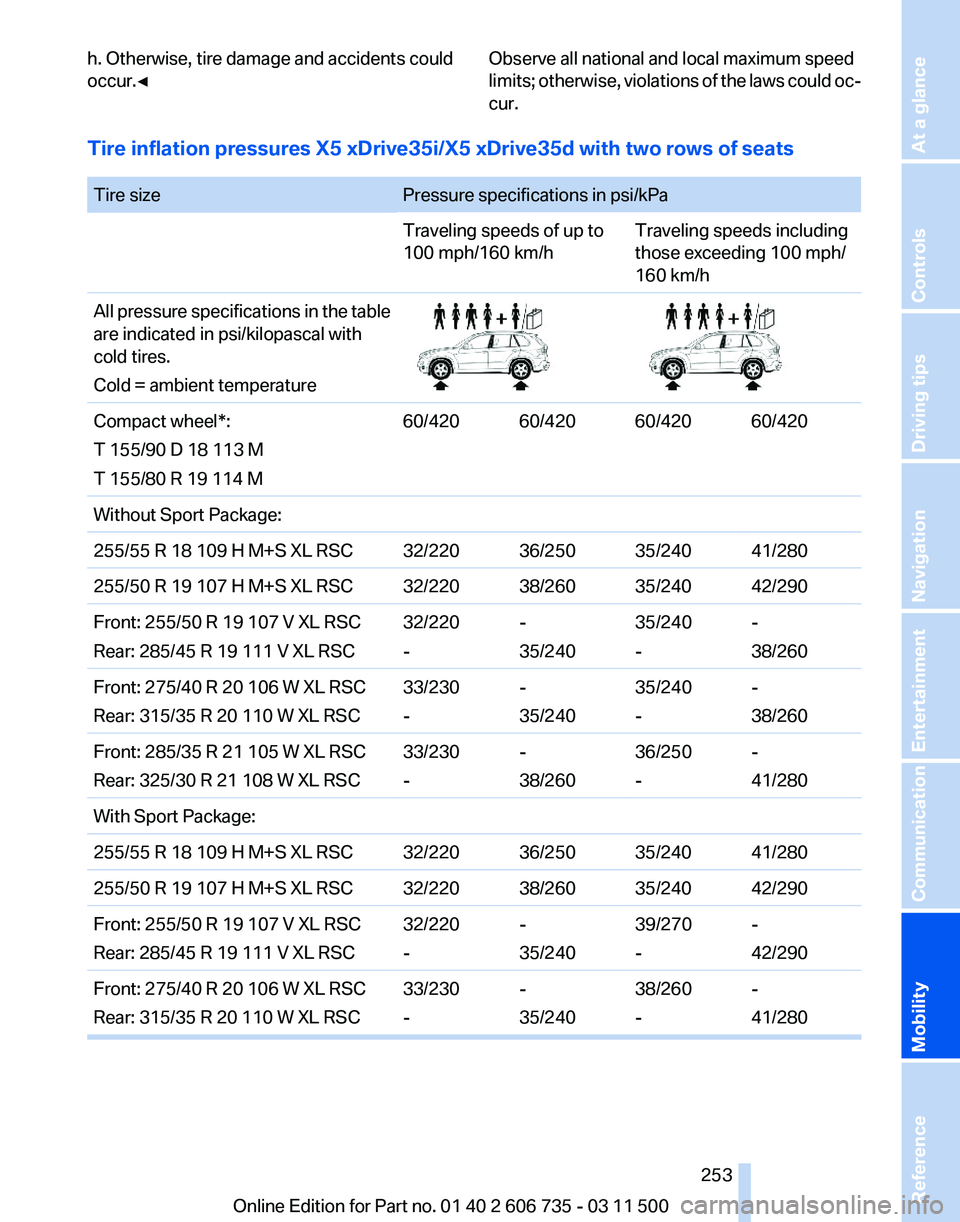
h. Otherwise, tire damage and accidents could
occur.◀
Observe all national and local maximum speed
limits;
otherwise, violations of the laws could oc‐
cur.
Tire inflation pressures X5 xDrive35i/X5 xDrive35d with two rows of seats
Tire size
Pressure specifications in psi/kPa
Traveling speeds of up to
100 mph/160 km/hTraveling speeds including
those exceeding 100 mph/
160 km/h
All pressure specifications in the table
are indicated in psi/kilopascal with
cold tires.
Cold = ambient temperature Compact wheel*:
T 155/90 D 18 113 M
T 155/80 R 19 114 M
60/420 60/420 60/420 60/420
Without Sport Package:
255/55 R 18 109 H M+S XL RSC 32/220 36/250 35/240 41/280
255/50 R 19 107 H M+S XL RSC 32/220 38/260 35/240 42/290
Front: 255/50 R 19 107 V XL RSC
Rear: 285/45 R 19 111 V XL RSC 32/220
--
35/24035/240
--
38/260
Front: 275/40 R 20 106 W XL RSC
Rear: 315/35 R 20 110 W XL RSC 33/230
--
35/24035/240
--
38/260
Front: 285/35 R 21 105 W XL RSC
Rear: 325/30 R 21 108 W XL RSC 33/230
--
38/26036/250
--
41/280
With Sport Package:
255/55 R 18 109 H M+S XL RSC 32/220 36/250 35/240 41/280
255/50 R 19 107 H M+S XL RSC 32/220 38/260 35/240 42/290
Front: 255/50 R 19 107 V XL RSC
Rear: 285/45 R 19 111 V XL RSC 32/220
--
35/24039/270
--
42/290
Front: 275/40 R 20 106 W XL RSC
Rear: 315/35 R 20 110 W XL RSC 33/230
--
35/24038/260
--
41/280 Seite 253
253Online Edition for Part no. 01 40 2 606 735 - 03 11 500
Reference
Mobility Communication Entertainment Navigation Driving tips Controls At a glance
Page 254 of 317
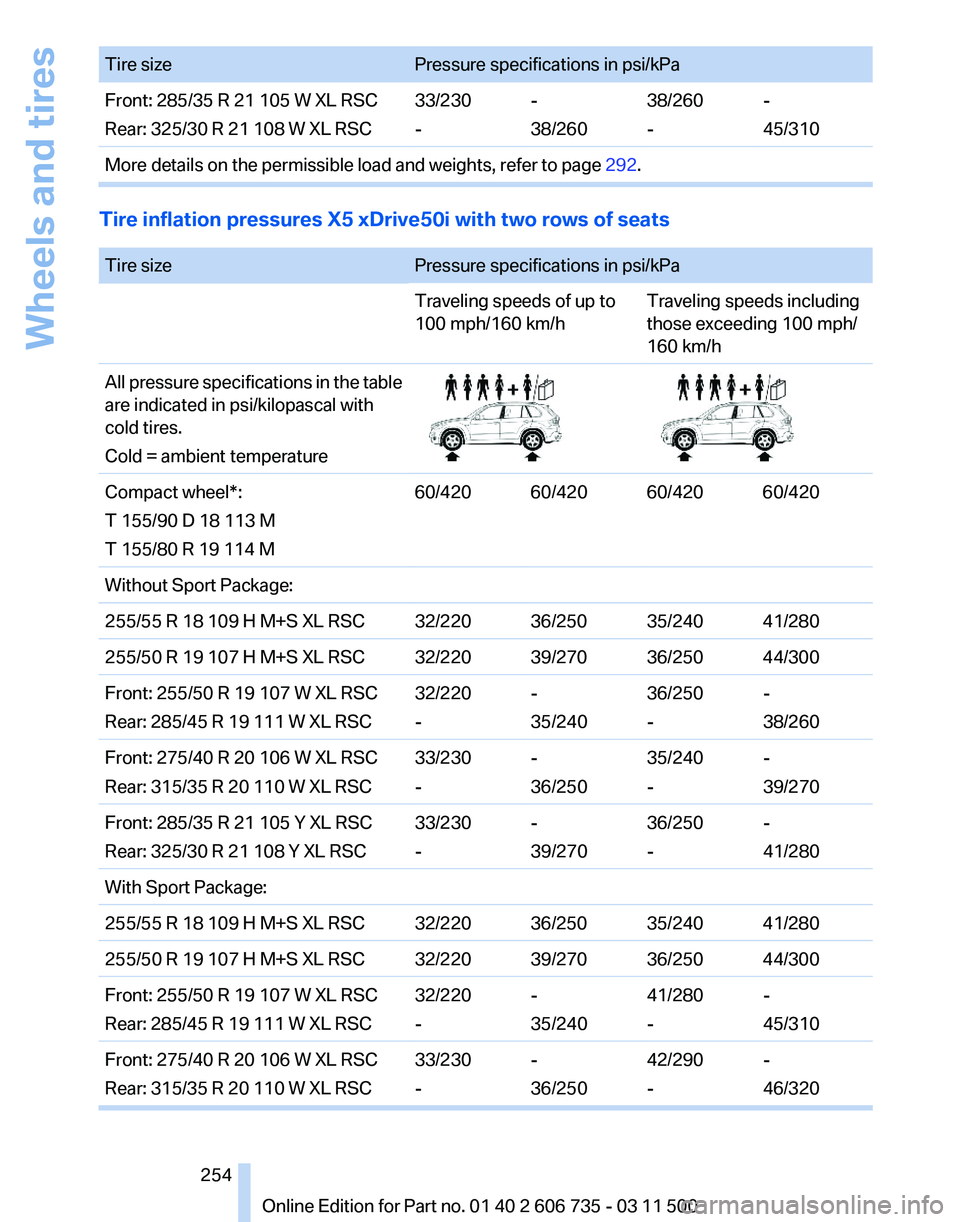
Tire size
Pressure specifications in psi/kPa
Front: 285/35 R 21 105 W XL RSC
Rear: 325/30 R 21 108 W XL RSC 33/230
--
38/26038/260
--
45/310
More details on the permissible load and weights, refer to page 292.Tire inflation pressures X5 xDrive50i with two rows of seats
Tire size
Pressure specifications in psi/kPa
Traveling speeds of up to
100 mph/160 km/hTraveling speeds including
those exceeding 100 mph/
160 km/h
All pressure specifications in the table
are indicated in psi/kilopascal with
cold tires.
Cold = ambient temperature Compact wheel*:
T 155/90 D 18 113 M
T 155/80 R 19 114 M
60/420 60/420 60/420 60/420
Without Sport Package:
255/55 R 18 109 H M+S XL RSC 32/220 36/250 35/240 41/280
255/50 R 19 107 H M+S XL RSC 32/220 39/270 36/250 44/300
Front: 255/50 R 19 107 W XL RSC
Rear: 285/45 R 19 111 W XL RSC 32/220
--
35/24036/250
--
38/260
Front: 275/40 R 20 106 W XL RSC
Rear: 315/35 R 20 110 W XL RSC 33/230
--
36/25035/240
--
39/270
Front: 285/35 R 21 105 Y XL RSC
Rear: 325/30 R 21 108 Y XL RSC 33/230
--
39/27036/250
--
41/280
With Sport Package:
255/55 R 18 109 H M+S XL RSC 32/220 36/250 35/240 41/280
255/50 R 19 107 H M+S XL RSC 32/220 39/270 36/250 44/300
Front: 255/50 R 19 107 W XL RSC
Rear: 285/45 R 19 111 W XL RSC 32/220
--
35/24041/280
--
45/310
Front: 275/40 R 20 106 W XL RSC
Rear: 315/35 R 20 110 W XL RSC 33/230
--
36/25042/290
--
46/320 Seite 254
254 Online Edition for Part no. 01 40 2 606 735 - 03 11 500Wheels and tires
Page 255 of 317
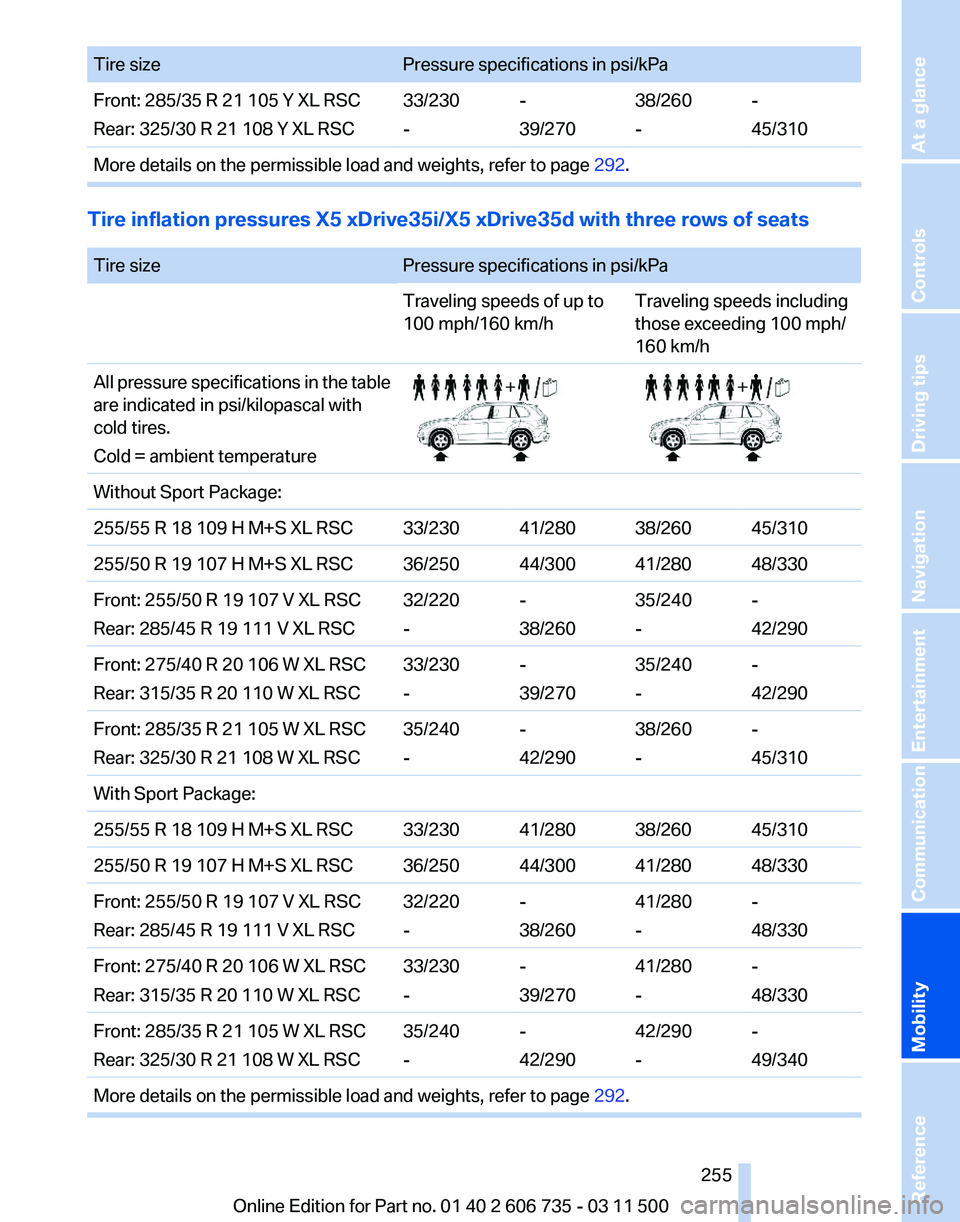
Tire size
Pressure specifications in psi/kPa
Front: 285/35 R 21 105 Y XL RSC
Rear: 325/30 R 21 108 Y XL RSC 33/230
--
39/27038/260
--
45/310
More details on the permissible load and weights, refer to page 292.Tire inflation pressures X5 xDrive35i/X5 xDrive35d with three rows of seats
Tire size
Pressure specifications in psi/kPa
Traveling speeds of up to
100 mph/160 km/hTraveling speeds including
those exceeding 100 mph/
160 km/h
All pressure specifications in the table
are indicated in psi/kilopascal with
cold tires.
Cold = ambient temperature Without Sport Package:
255/55 R 18 109 H M+S XL RSC 33/230 41/280 38/260 45/310
255/50 R 19 107 H M+S XL RSC 36/250 44/300 41/280 48/330
Front: 255/50 R 19 107 V XL RSC
Rear: 285/45 R 19 111 V XL RSC
32/220
--
38/26035/240
--
42/290
Front: 275/40 R 20 106 W XL RSC
Rear: 315/35 R 20 110 W XL RSC 33/230
--
39/27035/240
--
42/290
Front: 285/35 R 21 105 W XL RSC
Rear: 325/30 R 21 108 W XL RSC 35/240
--
42/29038/260
--
45/310
With Sport Package:
255/55 R 18 109 H M+S XL RSC 33/230 41/280 38/260 45/310
255/50 R 19 107 H M+S XL RSC 36/250 44/300 41/280 48/330
Front: 255/50 R 19 107 V XL RSC
Rear: 285/45 R 19 111 V XL RSC 32/220
--
38/26041/280
--
48/330
Front: 275/40 R 20 106 W XL RSC
Rear: 315/35 R 20 110 W XL RSC 33/230
--
39/27041/280
--
48/330
Front: 285/35 R 21 105 W XL RSC
Rear: 325/30 R 21 108 W XL RSC 35/240
--
42/29042/290
--
49/340
More details on the permissible load and weights, refer to page 292. Seite 255
255Online Edition for Part no. 01 40 2 606 735 - 03 11 500
Reference
Mobility Communication Entertainment Navigation Driving tips Controls At a glance
Page 256 of 317
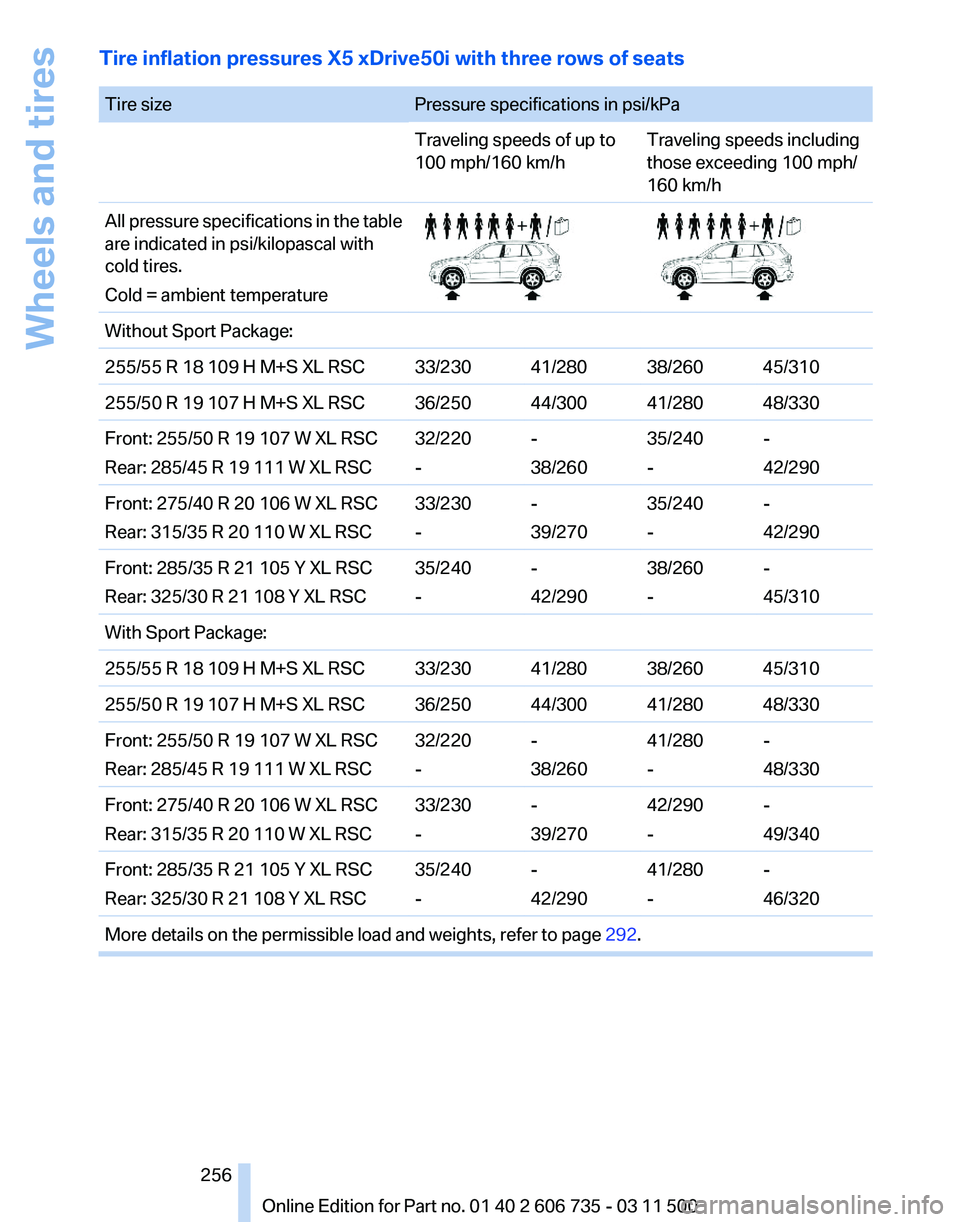
Tire inflation pressures X5 xDrive50i with three rows of seats
Tire size
Pressure specifications in psi/kPa
Traveling speeds of up to
100 mph/160 km/hTraveling speeds including
those exceeding 100 mph/
160 km/h
All pressure specifications in the table
are indicated in psi/kilopascal with
cold tires.
Cold = ambient temperature Without Sport Package:
255/55 R 18 109 H M+S XL RSC 33/230 41/280 38/260 45/310
255/50 R 19 107 H M+S XL RSC 36/250 44/300 41/280 48/330
Front: 255/50 R 19 107 W XL RSC
Rear: 285/45 R 19 111 W XL RSC
32/220
--
38/26035/240
--
42/290
Front: 275/40 R 20 106 W XL RSC
Rear: 315/35 R 20 110 W XL RSC 33/230
--
39/27035/240
--
42/290
Front: 285/35 R 21 105 Y XL RSC
Rear: 325/30 R 21 108 Y XL RSC 35/240
--
42/29038/260
--
45/310
With Sport Package:
255/55 R 18 109 H M+S XL RSC 33/230 41/280 38/260 45/310
255/50 R 19 107 H M+S XL RSC 36/250 44/300 41/280 48/330
Front: 255/50 R 19 107 W XL RSC
Rear: 285/45 R 19 111 W XL RSC 32/220
--
38/26041/280
--
48/330
Front: 275/40 R 20 106 W XL RSC
Rear: 315/35 R 20 110 W XL RSC 33/230
--
39/27042/290
--
49/340
Front: 285/35 R 21 105 Y XL RSC
Rear: 325/30 R 21 108 Y XL RSC 35/240
--
42/29041/280
--
46/320
More details on the permissible load and weights, refer to page 292. Seite 256
256 Online Edition for Part no. 01 40 2 606 735 - 03 11 500Wheels and tires
Page 257 of 317
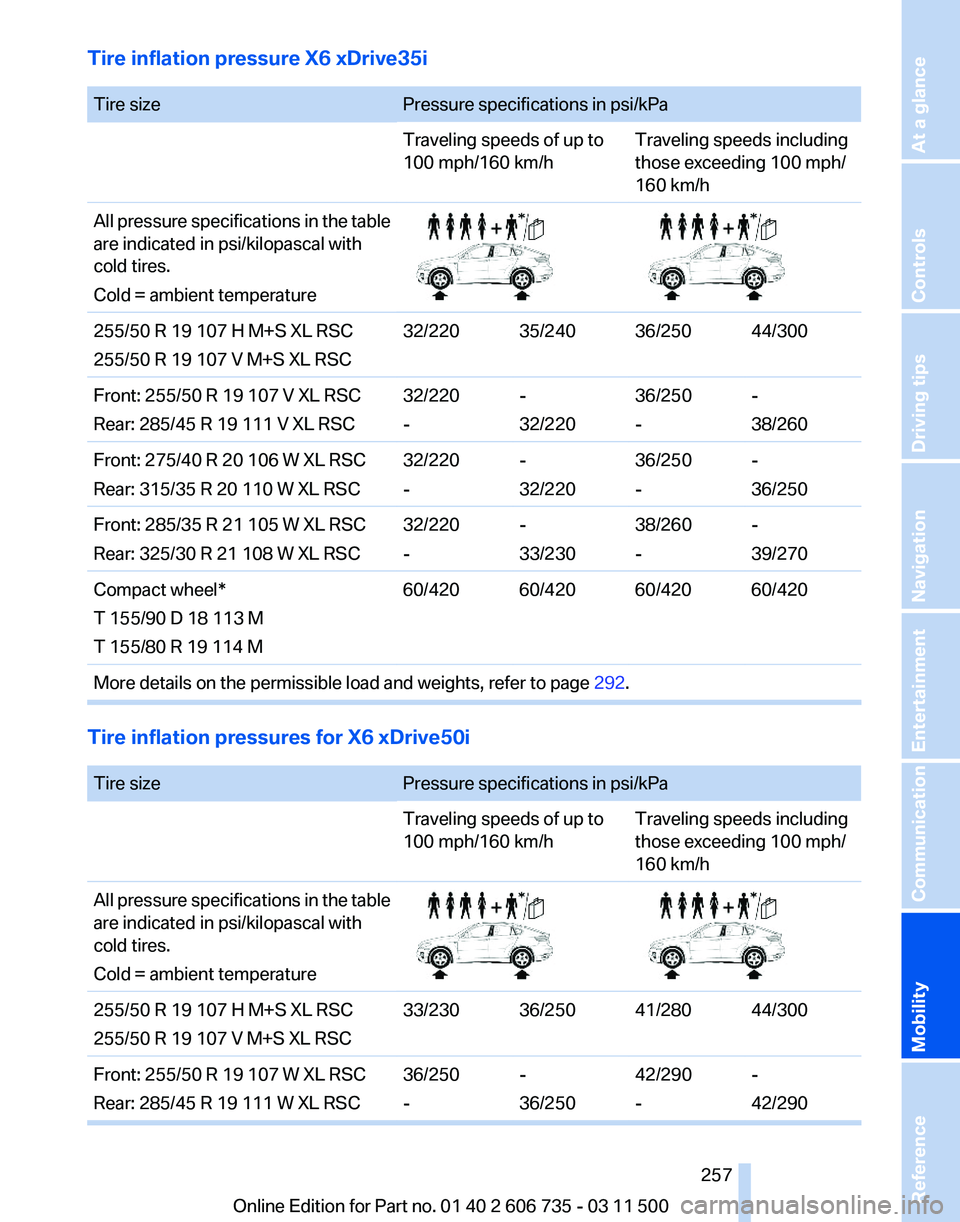
Tire inflation pressure X6 xDrive35i
Tire size
Pressure specifications in psi/kPa
Traveling speeds of up to
100 mph/160 km/hTraveling speeds including
those exceeding 100 mph/
160 km/h
All pressure specifications in the table
are indicated in psi/kilopascal with
cold tires.
Cold = ambient temperature 255/50 R 19 107 H M+S XL RSC
255/50 R 19 107 V M+S XL RSC
32/220 35/240 36/250 44/300
Front: 255/50 R 19 107 V XL RSC
Rear: 285/45 R 19 111 V XL RSC 32/220
--
32/22036/250
--
38/260
Front: 275/40 R 20 106 W XL RSC
Rear: 315/35 R 20 110 W XL RSC 32/220
--
32/22036/250
--
36/250
Front: 285/35 R 21 105 W XL RSC
Rear: 325/30 R 21 108 W XL RSC 32/220
--
33/23038/260
--
39/270
Compact wheel*
T 155/90 D 18 113 M
T 155/80 R 19 114 M 60/420 60/420 60/420 60/420
More details on the permissible load and weights, refer to page 292.Tire inflation pressures for X6 xDrive50i
Tire size
Pressure specifications in psi/kPa
Traveling speeds of up to
100 mph/160 km/hTraveling speeds including
those exceeding 100 mph/
160 km/h
All pressure specifications in the table
are indicated in psi/kilopascal with
cold tires.
Cold = ambient temperature 255/50 R 19 107 H M+S XL RSC
255/50 R 19 107 V M+S XL RSC
33/230 36/250 41/280 44/300
Front: 255/50 R 19 107 W XL RSC
Rear: 285/45 R 19 111 W XL RSC 36/250
--
36/25042/290
--
42/290 Seite 257
257Online Edition for Part no. 01 40 2 606 735 - 03 11 500
Reference
Mobility Communication Entertainment Navigation Driving tips Controls At a glance
Page 258 of 317
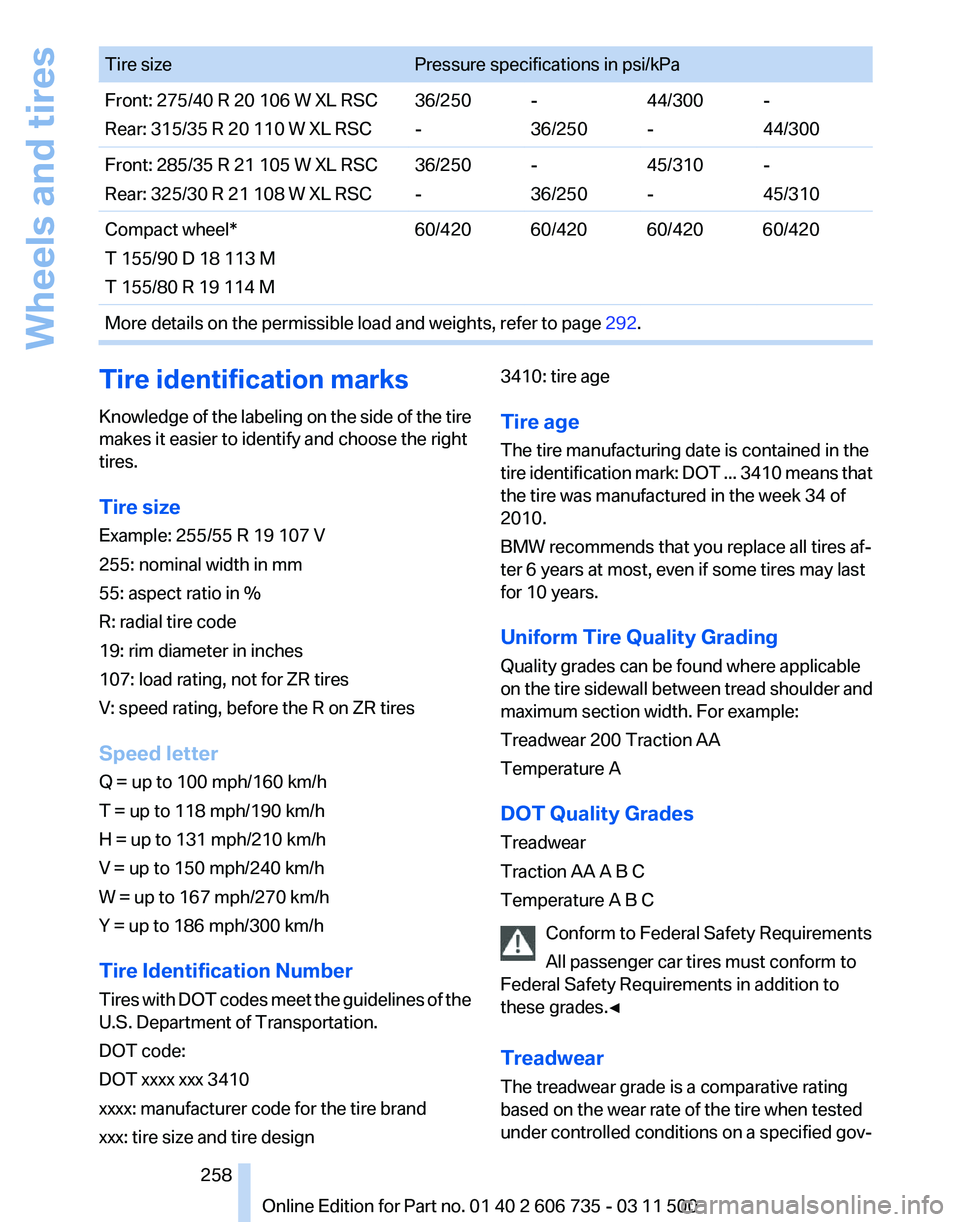
Tire size
Pressure specifications in psi/kPa
Front: 275/40 R 20 106 W XL RSC
Rear: 315/35 R 20 110 W XL RSC 36/250
--
36/25044/300
--
44/300
Front: 285/35 R 21 105 W XL RSC
Rear: 325/30 R 21 108 W XL RSC 36/250
--
36/25045/310
--
45/310
Compact wheel*
T 155/90 D 18 113 M
T 155/80 R 19 114 M 60/420 60/420 60/420 60/420
More details on the permissible load and weights, refer to page 292.Tire identification marks
Knowledge
of the labeling on the side of the tire
makes it easier to identify and choose the right
tires.
Tire size
Example: 255/55 R 19 107 V
255: nominal width in mm
55: aspect ratio in %
R: radial tire code
19: rim diameter in inches
107: load rating, not for ZR tires
V: speed rating, before the R on ZR tires
Speed letter
Q = up to 100 mph/160 km/h
T = up to 118 mph/190 km/h
H = up to 131 mph/210 km/h
V = up to 150 mph/240 km/h
W = up to 167 mph/270 km/h
Y = up to 186 mph/300 km/h
Tire Identification Number
Tires with DOT codes meet the guidelines of the
U.S. Department of Transportation.
DOT code:
DOT xxxx xxx 3410
xxxx: manufacturer code for the tire brand
xxx: tire size and tire design 3410: tire age
Tire age
The tire manufacturing date is contained in the
tire
identification mark: DOT ... 3410 means that
the tire was manufactured in the week 34 of
2010.
BMW recommends that you replace all tires af‐
ter 6 years at most, even if some tires may last
for 10 years.
Uniform Tire Quality Grading
Quality grades can be found where applicable
on the tire sidewall between tread shoulder and
maximum section width. For example:
Treadwear 200 Traction AA
Temperature A
DOT Quality Grades
Treadwear
Traction AA A B C
Temperature A B C
Conform to Federal Safety Requirements
All passenger car tires must conform to
Federal Safety Requirements in addition to
these grades.◀
Treadwear
The treadwear grade is a comparative rating
based on the wear rate of the tire when tested
under controlled conditions on a specified gov‐ Seite 258
258 Online Edition for Part no. 01 40 2 606 735 - 03 11 500
Wheels and tires
Page 259 of 317
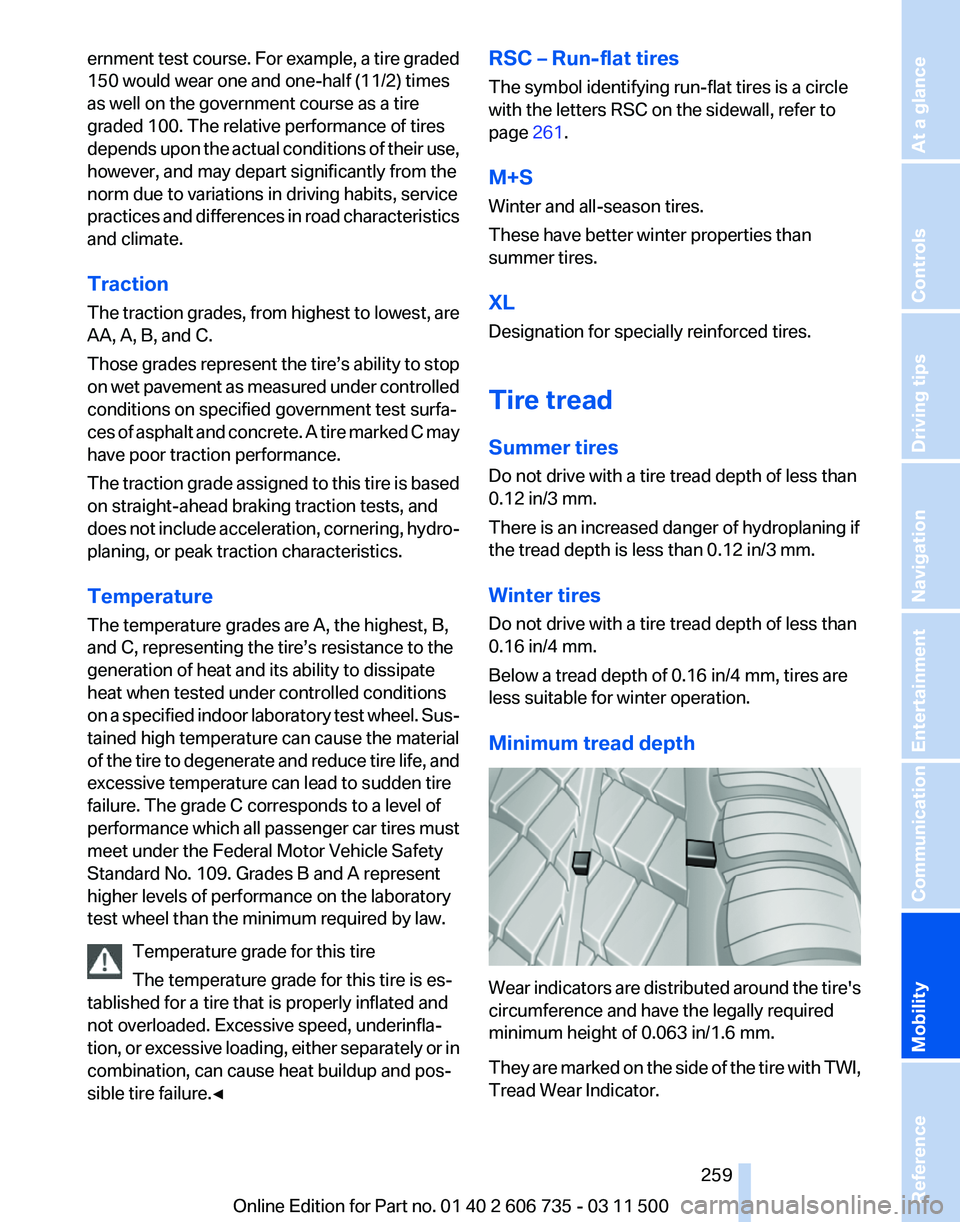
ernment test course. For example, a tire graded
150 would wear one and one-half (11/2) times
as well on the government course as a tire
graded 100. The relative performance of tires
depends
upon the actual conditions of their use,
however, and may depart significantly from the
norm due to variations in driving habits, service
practices and differences in road characteristics
and climate.
Traction
The traction grades, from highest to lowest, are
AA, A, B, and C.
Those grades represent the tire’s ability to stop
on wet pavement as measured under controlled
conditions on specified government test surfa‐
ces of asphalt and concrete. A tire marked C may
have poor traction performance.
The traction grade assigned to this tire is based
on straight-ahead braking traction tests, and
does not include acceleration, cornering, hydro‐
planing, or peak traction characteristics.
Temperature
The temperature grades are A, the highest, B,
and C, representing the tire’s resistance to the
generation of heat and its ability to dissipate
heat when tested under controlled conditions
on a specified indoor laboratory test wheel. Sus‐
tained high temperature can cause the material
of the tire to degenerate and reduce tire life, and
excessive temperature can lead to sudden tire
failure. The grade C corresponds to a level of
performance which all passenger car tires must
meet under the Federal Motor Vehicle Safety
Standard No. 109. Grades B and A represent
higher levels of performance on the laboratory
test wheel than the minimum required by law.
Temperature grade for this tire
The temperature grade for this tire is es‐
tablished for a tire that is properly inflated and
not overloaded. Excessive speed, underinfla‐
tion, or excessive loading, either separately or in
combination, can cause heat buildup and pos‐
sible tire failure.◀ RSC – Run-flat tires
The symbol identifying run-flat tires is a circle
with the letters RSC on the sidewall, refer to
page
261.
M+S
Winter and all-season tires.
These have better winter properties than
summer tires.
XL
Designation for specially reinforced tires.
Tire tread
Summer tires
Do not drive with a tire tread depth of less than
0.12 in/3 mm.
There is an increased danger of hydroplaning if
the tread depth is less than 0.12 in/3 mm.
Winter tires
Do not drive with a tire tread depth of less than
0.16 in/4 mm.
Below a tread depth of 0.16 in/4 mm, tires are
less suitable for winter operation.
Minimum tread depth Wear indicators are distributed around the tire's
circumference and have the legally required
minimum height of 0.063 in/1.6 mm.
They
are marked on the side of the tire with TWI,
Tread Wear Indicator.
Seite 259
259Online Edition for Part no. 01 40 2 606 735 - 03 11 500
Reference
Mobility Communication Entertainment Navigation Driving tips Controls At a glance
Page 260 of 317
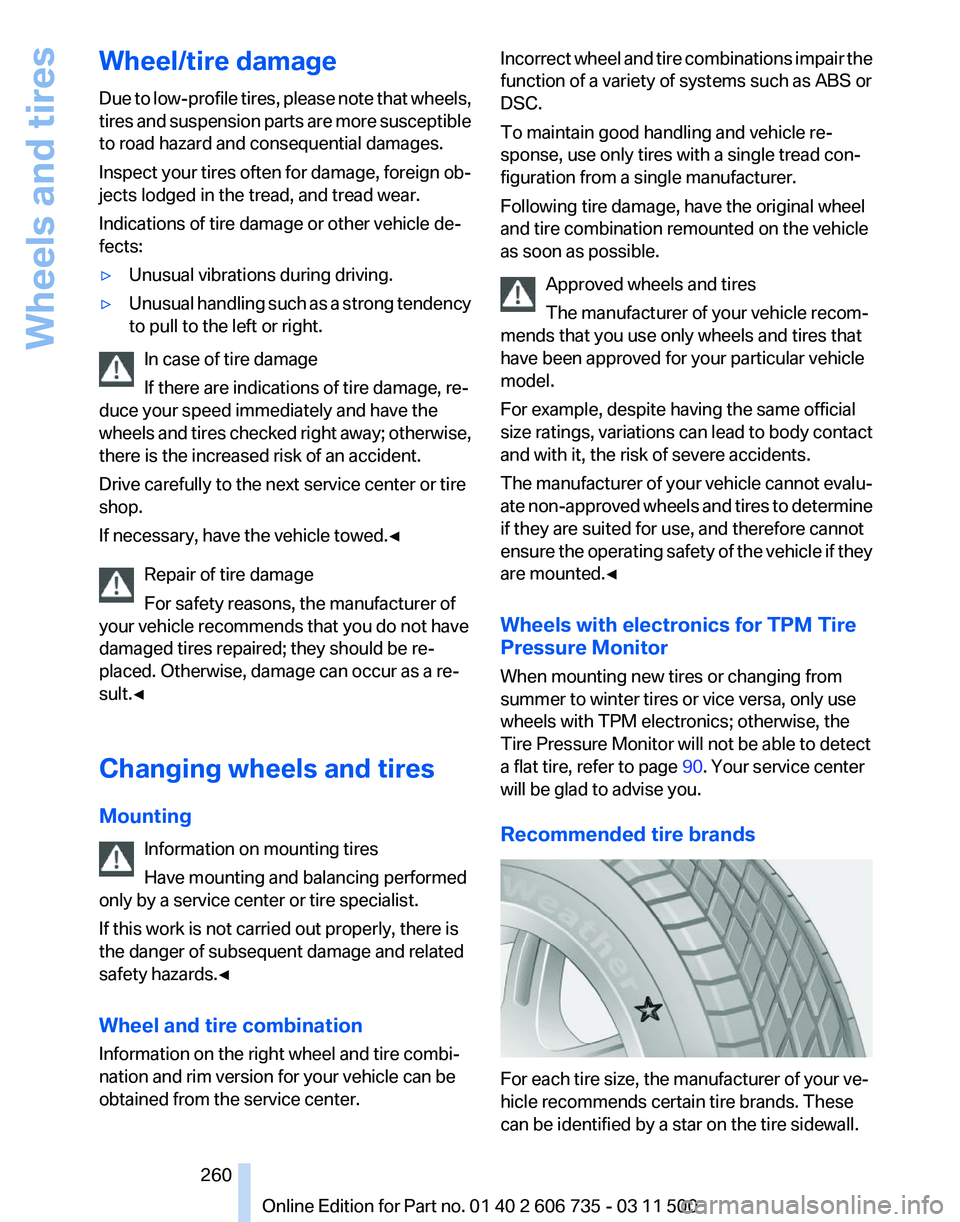
Wheel/tire damage
Due
to low-profile tires, please note that wheels,
tires and suspension parts are more susceptible
to road hazard and consequential damages.
Inspect your tires often for damage, foreign ob‐
jects lodged in the tread, and tread wear.
Indications of tire damage or other vehicle de‐
fects:
▷ Unusual vibrations during driving.
▷ Unusual handling such as a strong tendency
to pull to the left or right.
In case of tire damage
If there are indications of tire damage, re‐
duce your speed immediately and have the
wheels
and tires checked right away; otherwise,
there is the increased risk of an accident.
Drive carefully to the next service center or tire
shop.
If necessary, have the vehicle towed.◀
Repair of tire damage
For safety reasons, the manufacturer of
your vehicle recommends that you do not have
damaged tires repaired; they should be re‐
placed. Otherwise, damage can occur as a re‐
sult.◀
Changing wheels and tires
Mounting
Information on mounting tires
Have mounting and balancing performed
only by a service center or tire specialist.
If this work is not carried out properly, there is
the danger of subsequent damage and related
safety hazards.◀
Wheel and tire combination
Information on the right wheel and tire combi‐
nation and rim version for your vehicle can be
obtained from the service center. Incorrect wheel and tire combinations impair the
function of a variety of systems such as ABS or
DSC.
To maintain good handling and vehicle re‐
sponse, use only tires with a single tread con‐
figuration from a single manufacturer.
Following tire damage, have the original wheel
and tire combination remounted on the vehicle
as soon as possible.
Approved wheels and tires
The manufacturer of your vehicle recom‐
mends that you use only wheels and tires that
have been approved for your particular vehicle
model.
For example, despite having the same official
size
ratings, variations can lead to body contact
and with it, the risk of severe accidents.
The manufacturer of your vehicle cannot evalu‐
ate non-approved wheels and tires to determine
if they are suited for use, and therefore cannot
ensure the operating safety of the vehicle if they
are mounted.◀
Wheels with electronics for TPM Tire
Pressure Monitor
When mounting new tires or changing from
summer to winter tires or vice versa, only use
wheels with TPM electronics; otherwise, the
Tire Pressure Monitor will not be able to detect
a flat tire, refer to page 90. Your service center
will be glad to advise you.
Recommended tire brands For each tire size, the manufacturer of your ve‐
hicle recommends certain tire brands. These
can be identified by a star on the tire sidewall. Seite 260
260 Online Edition for Part no. 01 40 2 606 735 - 03 11 500
Wheels and tires